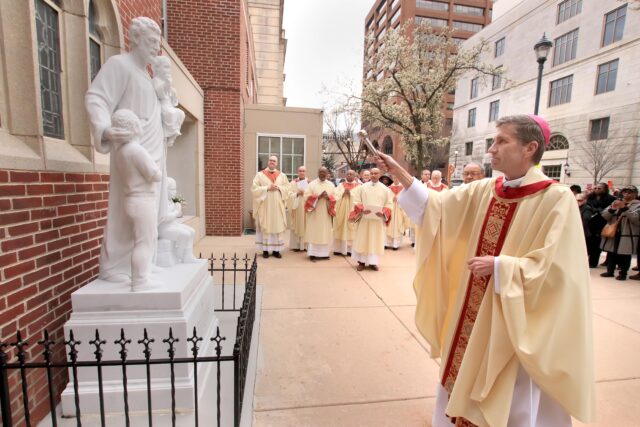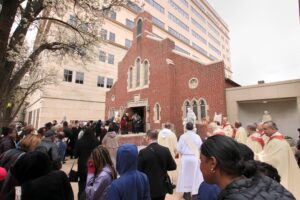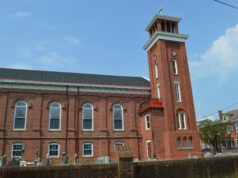
St. Joseph’s Church in Wilmington celebrated its 135th anniversary with the dedication of a new statue commemorating its legacy of community service and honoring its patron saint on his feast day, March 19.
The custom-made, Carrara marble statue, which was installed in January, rests on a pedestal bearing the inscription: In Memory of St. Joseph’s Orphanage for Colored Boys. First in the United States of America 1893 – 1928.
Among the attendees at the event were religious and laity with past and present ties to the parish, including: the Sisters of St. Francis, whose predecessors taught and cared for the little “sun-kissed angels;” Brenda Burns, director of the diocese’s Ministry for Black Catholics; and State Rep. Stephanie T. Bolden, who secured funding for the project.
Bishop Koenig blessed the statue before entering the church to celebrate Mass.
The Very Rev. Glenn M. Evers, V.C., pastor of St. Joseph’s and director of the diocese’s Office for Cultural Ministries, delivered a spirited homily, recounting the statue’s back story to an assemblage as eager to hear it as he was to tell it.
The original — and undated — concrete statue had fallen into serious disrepair. Its facial features were worn away, and some limbs were broken off. Money had been donated for a renovation, but the statue was clearly beyond repair.

“We needed a new statue,” Evers said.
Evers contacted a statue broker, but nothing in stock matched their needs.
“Our statue was unique,” he said.
Evers envisioned a custom design made of the “best stone God ever made.” That would be Carrara marble, the same material carved by the likes of Michelangelo and Leonardo da Vinci.
Evers wondered if he could even find 21st-century artisans skilled in the ancient art of stone carving. He found them in the northwestern Italian city of Pietrasanta.
But cost of such a project would be well beyond the parish’s reach. They barely had the money for a down payment, let alone the funds needed for the labor, shipping and the gate that would surround and protect the statue.
Then God intervened in the person of Bolden. “She ‘sealed the deal,’ and got us the funding,” Evers said.
Evers had one more challenge: to find models for the faces of the figures. Models that would connect the statue to the worlds of Christ: “Whatsoever you do to the least of my brothers, that you do unto me.”
Neither the original statue nor the blurry, archival photos of the orphaned boys were of any use.
Then he remembered the face of the Christ Child in the “Our Mother of Africa” chapel in Washington, D.C. That image served as the face for the kneeling boy in the statue.
Evers then asked himself: What becomes of children who are cared for and nurtured? They adopt virtues and go on to accomplish great things. “They grow up to become saints,” he said.
The face of St. Martin de Porres became the model for the face of the standing boy. St. Martin de Pores is the patron saint of people of mixed races, noted for his unconditional care of all people.
Behind them stands the image of St. Joseph, the model of total obedience to God’s commands and his selfless love of neighbor. “Our neighbors are not our families,” said Evers. St. Joseph adopted Jesus. He was not his biological son.”
The evening’s Mass featured another tribute to St. Joseph. A new hymn, “St. Joseph, Build Me a Staircase,” which was composed collaboratively by the parish choir and its music minister, Daniel Stevens.
Evers had to solve one more problem: the disposition of the original statue. He couldn’t bear the thought of taking a hammer to it. And he didn’t have to. Their friends at St. Joseph’s on the Brandywine took the statue and placed it in the old cemetery behind the church.
“It’s retired there,” said Evers. “Just like the others there retired to eternity.







